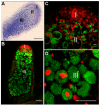Involvement of Glutaredoxin and Thioredoxin Systems in the Nitrogen-Fixing Symbiosis between Legumes and Rhizobia
- PMID: 30563061
- PMCID: PMC6315971
- DOI: 10.3390/antiox7120182
Involvement of Glutaredoxin and Thioredoxin Systems in the Nitrogen-Fixing Symbiosis between Legumes and Rhizobia
Abstract
Leguminous plants can form a symbiotic relationship with Rhizobium bacteria, during which plants provide bacteria with carbohydrates and an environment appropriate to their metabolism, in return for fixed atmospheric nitrogen. The symbiotic interaction leads to the formation of a new organ, the root nodule, where a coordinated differentiation of plant cells and bacteria occurs. The establishment and functioning of nitrogen-fixing symbiosis involves a redox control important for both the plant-bacteria crosstalk and the regulation of nodule metabolism. In this review, we discuss the involvement of thioredoxin and glutaredoxin systems in the two symbiotic partners during symbiosis. The crucial role of glutathione in redox balance and S-metabolism is presented. We also highlight the specific role of some thioredoxin and glutaredoxin systems in bacterial differentiation. Transcriptomics data concerning genes encoding components and targets of thioredoxin and glutaredoxin systems in connection with the developmental step of the nodule are also considered in the model system Medicago truncatula⁻Sinorhizobium meliloti.
Keywords: glutaredoxin; legume plant; redox homeostasis; stress; symbiosis; thioredoxin.
Conflict of interest statement
The authors declare no conflict of interest.
Figures


References
Publication types
Grants and funding
LinkOut - more resources
Full Text Sources

